seats Lancia Delta 2010 Owner handbook (in English)
[x] Cancel search | Manufacturer: LANCIA, Model Year: 2010, Model line: Delta, Model: Lancia Delta 2010Pages: 276, PDF Size: 5.31 MB
Page 151 of 276
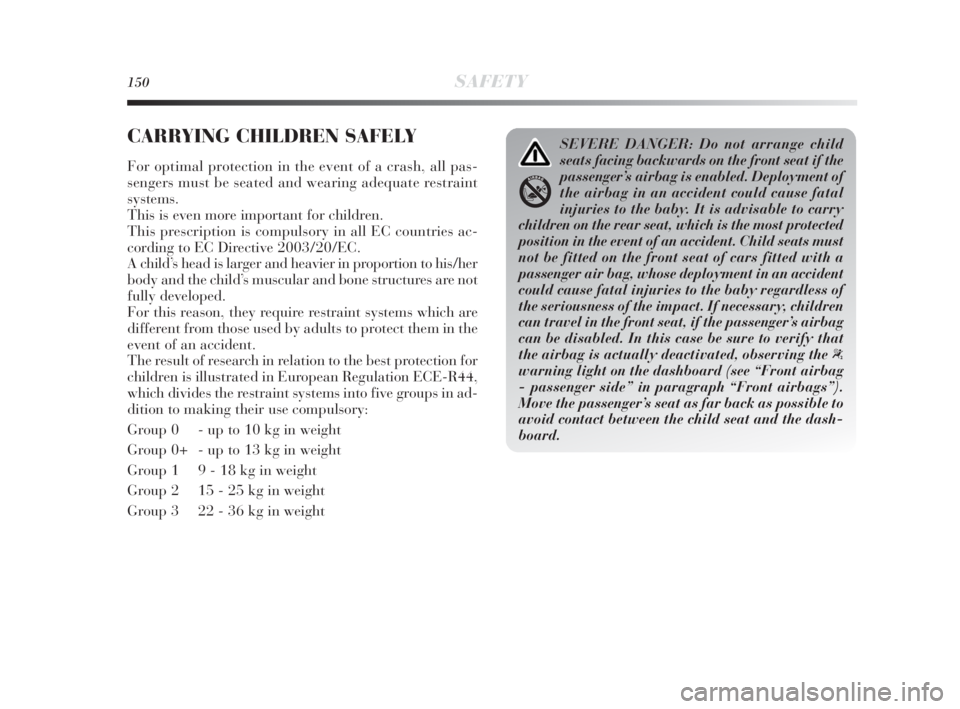
150SAFETY
CARRYING CHILDREN SAFELY
For optimal protection in the event of a crash, all pas-
sengers must be seated and wearing adequate restraint
systems.
This is even more important for children.
This prescription is compulsory in all EC countries ac-
cording to EC Directive 2003/20/EC.
A child’s head is larger and heavier in proportion to his/her
body and the child’s muscular and bone structures are not
fully developed.
For this reason, they require restraint systems which are
different from those used by adults to protect them in the
event of an accident.
The result of research in relation to the best protection for
children is illustrated in European Regulation ECE-R44,
which divides the restraint systems into five groups in ad-
dition to making their use compulsory:
Group 0 - up to 10 kg in weight
Group 0+ - up to 13 kg in weight
Group 1 9 - 18 kg in weight
Group 2 15 - 25 kg in weight
Group 3 22 - 36 kg in weight
SEVERE DANGER: Do not arrange child
seats facing backwards on the front seat if the
passenger’s airbag is enabled. Deployment of
the airbag in an accident could cause fatal
injuries to the baby. It is advisable to carry
children on the rear seat, which is the most protected
position in the event of an accident. Child seats must
not be fitted on the front seat of cars fitted with a
passenger air bag, whose deployment in an accident
could cause fatal injuries to the baby regardless of
the seriousness of the impact. If necessary, children
can travel in the front seat, if the passenger’s airbag
can be disabled. In this case be sure to verify that
the airbag is actually deactivated, observing the
“
warning light on the dashboard (see “Front airbag
- passenger side” in paragraph “Front airbags”).
Move the passenger’s seat as far back as possible to
avoid contact between the child seat and the dash-
board.
143-164 Delta 4ed gb 12-02-2010 10:20 Pagina 150
Page 152 of 276
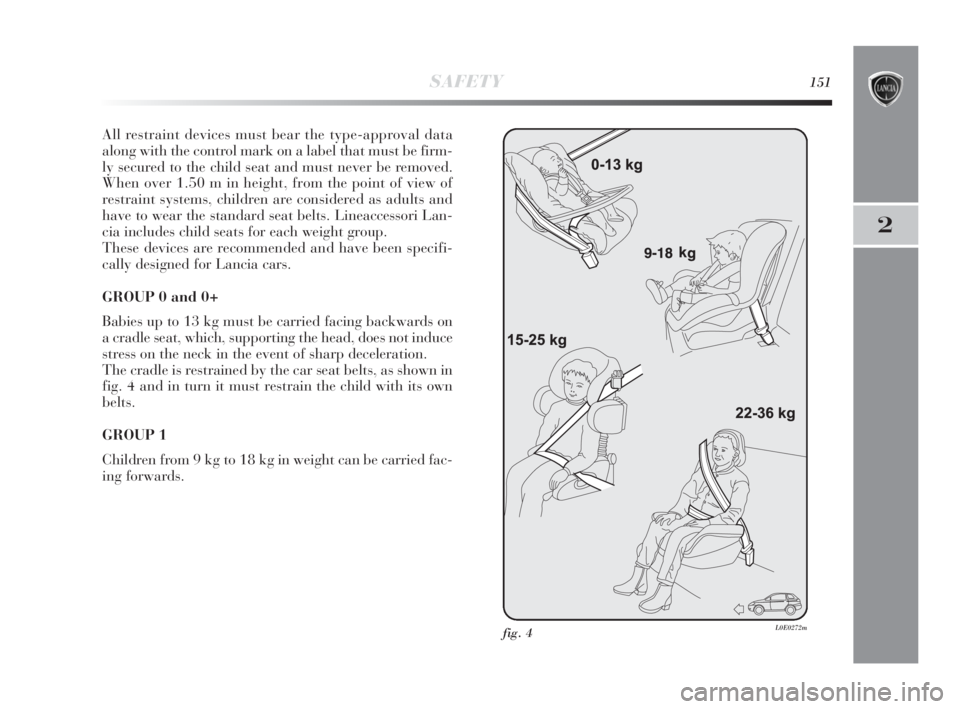
SAFETY151
2
All restraint devices must bear the type-approval data
along with the control mark on a label that must be firm-
ly secured to the child seat and must never be removed.
When over 1.50 m in height, from the point of view of
restraint systems, children are considered as adults and
have to wear the standard seat belts. Lineaccessori Lan-
cia includes child seats for each weight group.
These devices are recommended and have been specifi-
cally designed for Lancia cars.
GROUP 0 and 0+
Babies up to 13 kg must be carried facing backwards on
a cradle seat, which, supporting the head, does not induce
stress on the neck in the event of sharp deceleration.
The cradle is restrained by the car seat belts, as shown in
fig. 4 and in turn it must restrain the child with its own
belts.
GROUP 1
Children from 9 kg to 18 kg in weight can be carried fac-
ing forwards.
fig. 4L0E0272m
143-164 Delta 4ed gb 12-02-2010 10:20 Pagina 151
Page 153 of 276
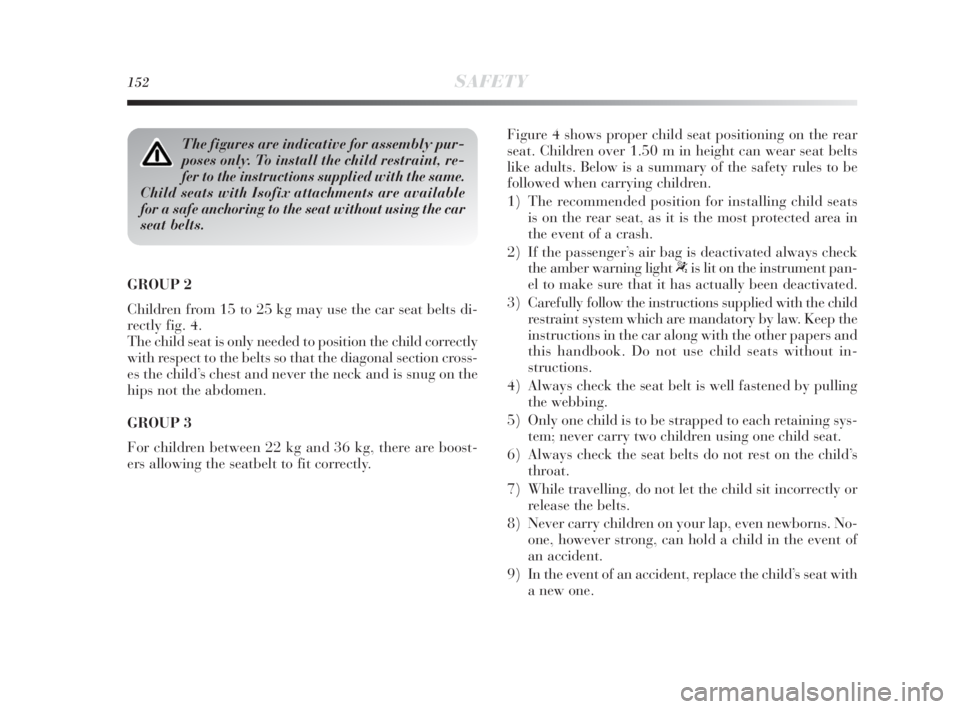
152SAFETY
GROUP 2
Children from 15 to 25 kg may use the car seat belts di-
rectly fig. 4.
The child seat is only needed to position the child correctly
with respect to the belts so that the diagonal section cross-
es the child’s chest and never the neck and is snug on the
hips not the abdomen.
GROUP 3
For children between 22 kg and 36 kg, there are boost-
ers allowing the seatbelt to fit correctly.Figure 4 shows proper child seat positioning on the rear
seat. Children over 1.50 m in height can wear seat belts
like adults. Below is a summary of the safety rules to be
followed when carrying children.
1) The recommended position for installing child seats
is on the rear seat, as it is the most protected area in
the event of a crash.
2) If the passenger’s air bag is deactivated always check
the amber warning light “is lit on the instrument pan-
el to make sure that it has actually been deactivated.
3) Carefully follow the instructions supplied with the child
restraint system which are mandatory by law. Keep the
instructions in the car along with the other papers and
this handbook. Do not use child seats without in-
structions.
4) Always check the seat belt is well fastened by pulling
the webbing.
5) Only one child is to be strapped to each retaining sys-
tem; never carry two children using one child seat.
6) Always check the seat belts do not rest on the child’s
throat.
7) While travelling, do not let the child sit incorrectly or
release the belts.
8) Never carry children on your lap, even newborns. No-
one, however strong, can hold a child in the event of
an accident.
9) In the event of an accident, replace the child’s seat with
a new one.
The figures are indicative for assembly pur-
poses only. To install the child restraint, re-
fer to the instructions supplied with the same.
Child seats with Isofix attachments are available
for a safe anchoring to the seat without using the car
seat belts.
143-164 Delta 4ed gb 12-02-2010 10:20 Pagina 152
Page 154 of 276
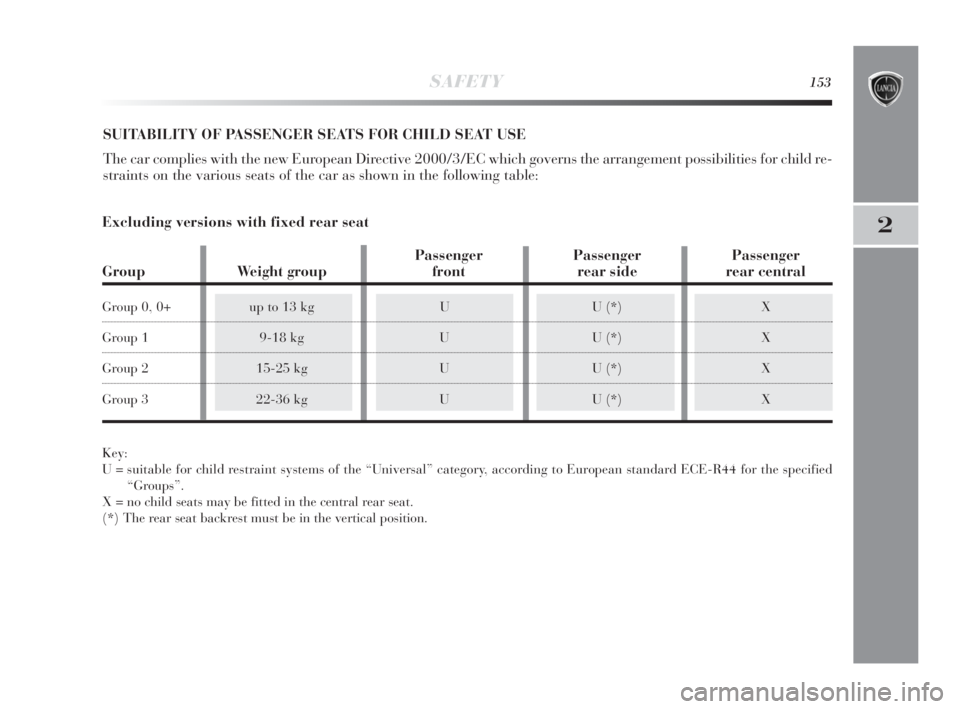
SAFETY153
2
SUITABILITY OF PASSENGER SEATS FOR CHILD SEAT USE
The car complies with the new European Directive 2000/3/EC which governs the arrangement possibilities for child re-
straints on the various seats of the car as shown in the following table:
Key:
U = suitable for child restraint systems of the “Universal” category, according to European standard ECE-R44 for the specified
“Groups”.
X = no child seats may be fitted in the central rear seat.
(*) The rear seat backrest must be in the vertical position.
Passenger Passenger Passenger
Group Weight group front rear side rear central
Group 0, 0+ up to 13 kg U U (*) X
Group 1 9-18 kg U U (*) X
Group 2 15-25 kg U U (*) X
Group 3 22-36 kg U U (*) X
Excluding versions with fixed rear seat
143-164 Delta 4ed gb 12-02-2010 10:20 Pagina 153
Page 155 of 276

154SAFETY
Only for versions with fixed rear seat
Key:
U = suitable for child restraint systems of the “Universal” category, according to European standard ECE-R44 for the specified
“Groups”.
X = corresponds to the rear side seat (driver's side) not possible to fit any type child seats.
Passenger Passenger
Passenger rear side Passenger rear side
Group Weight group front (passenger side) read central (driver's side)
Group 0, 0+ up to 13 kg U U U X
Group 1 9-18 kg U U U X
Group 2 15-25 kg U U U X
Group 3 22-36 kg U U U X
143-164 Delta 4ed gb 12-02-2010 10:20 Pagina 154
Page 156 of 276
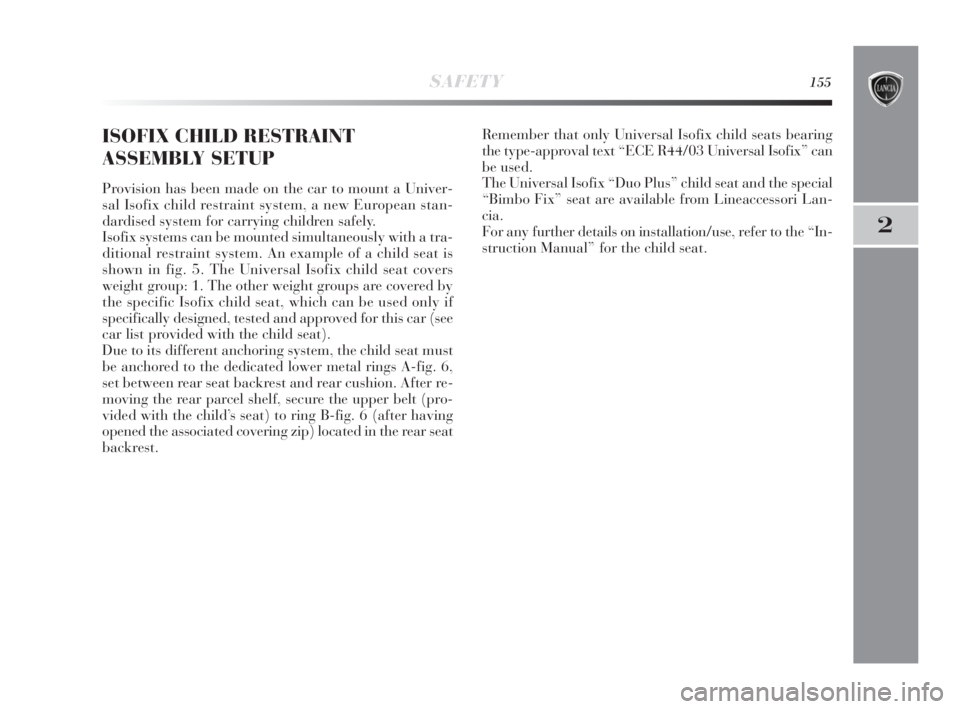
SAFETY155
2
ISOFIX CHILD RESTRAINT
ASSEMBLY SETUP
Provision has been made on the car to mount a Univer-
sal Isofix child restraint system, a new European stan-
dardised system for carrying children safely.
Isofix systems can be mounted simultaneously with a tra-
ditional restraint system. An example of a child seat is
shown in fig. 5. The Universal Isofix child seat covers
weight group: 1. The other weight groups are covered by
the specific Isofix child seat, which can be used only if
specifically designed, tested and approved for this car (see
car list provided with the child seat).
Due to its different anchoring system, the child seat must
be anchored to the dedicated lower metal rings A-fig. 6,
set between rear seat backrest and rear cushion. After re-
moving the rear parcel shelf, secure the upper belt (pro-
vided with the child’s seat) to ring B-fig. 6 (after having
opened the associated covering zip) located in the rear seat
backrest. Remember that only Universal Isofix child seats bearing
the type-approval text “ECE R44/03 Universal Isofix” can
be used.
The Universal Isofix “Duo Plus” child seat and the special
“Bimbo Fix” seat are available from Lineaccessori Lan-
cia.
For any further details on installation/use, refer to the “In-
struction Manual” for the child seat.
143-164 Delta 4ed gb 12-02-2010 10:20 Pagina 155
Page 158 of 276

SAFETY157
2
PASSENGER SEAT COMPLIANCE WITH REGULATIONS ON UNIVERSAL ISOFIX CHILD SEAT USE
The table below shows the different installation possibilities of Isofix restraint systems on seats fitted with Isofix fas-
teners in compliance with European standard ECE 16.
IUF: suitable for Isofix child restraint systems to be set facing forwards, universal class (fitted with third upper fastener), ap-
proved for the relevant weight group.
IL: suitable for special child restraint systems, specific Isofix type, and type-approved for this type of car.
X: Isofix position not suitable for Isofix child restraint systems in this weight group and/or size.
Weight group Orientation Grade Isofix position
child seat Isofix size side rear
Portable cradle Side F-G IL
Group 0 up to 10 kg Facing backwards E IL
Facing backwards E IL
Group 0 + up to 13 kg Facing backwards D IL
Facing backwards C IL
Facing backwards D IL
Facing backwards C IL
Group 1 from 9 to 18 kg Facing forwards B IUF
Facing forwards B1 IUF
Facing forwards A IUF
143-164 Delta 4ed gb 12-02-2010 10:20 Pagina 157
Page 159 of 276

158SAFETY
FRONT AIRBAGS
The car is provided with front air bags for the driver and
the passenger, driver’s knee air bag (for versions/markets,
where provided) and front side bags (side bags - window
bags).
The front airbags (driver’s, passenger’s, driver’s knee air
bags) have been designed to protect the occupants in the
event of head-on crashes of medium-high severity, by plac-
ing a cushion between the occupant and the steering wheel
or dashboard.
Front air bags are designed to protect car’s occupants in
head-on crashes and therefore non-activation in other
types of collisions (side collisions, rear shunts, roll-overs,
etc.) is not a system malfunction.
An electronic control unit causes the bag to inflate in the
event of a head-on crash.
The bag will inflate instantaneously placing itself between
the front occupant’s body and the structures which could
cause injury. It will deflate immediately afterwards.
The front airbags (driver’s, passenger’s, driver’s knee air
bags) do not replace but rather complement the seat belts,
which you are always recommended to wear, as specified
by law in Europe and most non-European countries.
In the event of a collision, a person not wearing a seat belt
may be thrown forward and come into contact with the
bag before it has fully opened. The protection offered by
the bag is reduced in such a case.The front airbags may not be activated in the following sit-
uations:
❍in collisions against highly deformable objects not af-
fecting the front surface of the car (e.g. bumper colli-
sion against guard rail, etc.);
❍car penetration under other vehicles or protective bar-
riers (e.g. trucks or guard rails);
in these instances they would not provide any additional
protection compared with the seat belts, so their deploy-
ment would be improper. Non deployment in such cases
does not constitute a fault.
Do not apply stickers or other objects to the
steering wheel, the dashboard in the passen-
ger-side airbag area, the roof side upholstery
or the seats. Do not place objects (e.g. cell phones)
on the passenger-side dashboard because these
could interfere with the correct opening of the airbag
and cause severe injury to occupants.
143-164 Delta 4ed gb 12-02-2010 10:20 Pagina 158
Page 161 of 276

160SAFETY
DRIVER’S KNEE AIR BAG fig, 9
(for versions/markets, where provided)
This consists of an instant-inflating cushion housed into
a special compartment provided for the purpose under the
lower steering column guard at driver’s knee level. It is de-
signed to give further protection in the event of frontal
crash.MANUAL DEACTIVATION OF PASSENGER’S
FRONT AIR BAG AND SIDE BAG
Should it be absolutely necessary to carry a child on the
front seat, the passenger’s front air bag and the Side Bag
can be deactivated.
The instrument panel warning light
“will stay on glow-
ing steadily until the passenger’s front air bag and the Side
Bag is reactivated.
IMPORTANT To manually deactivate the passenger’s front
air bag and the Side Bag (for versions/markets, where pro-
vided), refer to paragraphs “Multifunctional display” and
“Reconfigurable multifunctional display” in section “Get-
ting to know your car”.
SEVERE DANGER: Do not arrange child
seats facing backwards if the passenger’s
front airbag is on. Deployment of the airbag
in an accident could cause fatal injuries to
the baby. Always deactivate the passenger’s
airbag when placing a child seat on the front seat.
Move the passenger’s seat as far back as possible to
avoid contact between the child seat and the dash-
board. Although this is not mandatory by law, the
airbag should be immediately reactivated when
children are no longer carried to ensure better pro-
tection to adults.
fig. 9L0E0069m
143-164 Delta 4ed gb 12-02-2010 10:20 Pagina 160
Page 165 of 276

164SAFETY
With ignition key inserted and turned to
MAR, the air bags can activate even if the en-
gine is off and the car is at a standstill, if it
is hit by another vehicle. For this reason, children
must never sit on the front seat, even if the car is not
moving. We remind you that if the key is inserted
and turned to STOP, no safety device (air bag or
pretensioner) activates following a collision; non-
deployment in such cases is consequently not the
sign of a fault.
When the key is turned to MAR, the warn-
ing light “turns on, blinking for a few sec-
onds, to remind you that the passenger air
bag will activate in the event of a collision, then it
turns off.
Do not wash the seats with pressurized wa-
ter or steam (manually or at the automatic
washing stations).
The front airbags deploy in the event of more
severe collisions than those required for de-
ploying the pretensioners. For collisions in
the range between the two activation thresholds,
pretensioner activation is normal.
Do not hook rigid objects to clothes hangers
and support handles.
The airbag does not replace the seat belts, it
increases their effectiveness. Furthermore,
since front airbags are not deployed in low
speed collisions, side collisions, rear-end shunts
or roll-overs, the passengers are only protected by
the seat belts which must be fastened at all times.
143-164 Delta 4ed gb 12-02-2010 10:20 Pagina 164